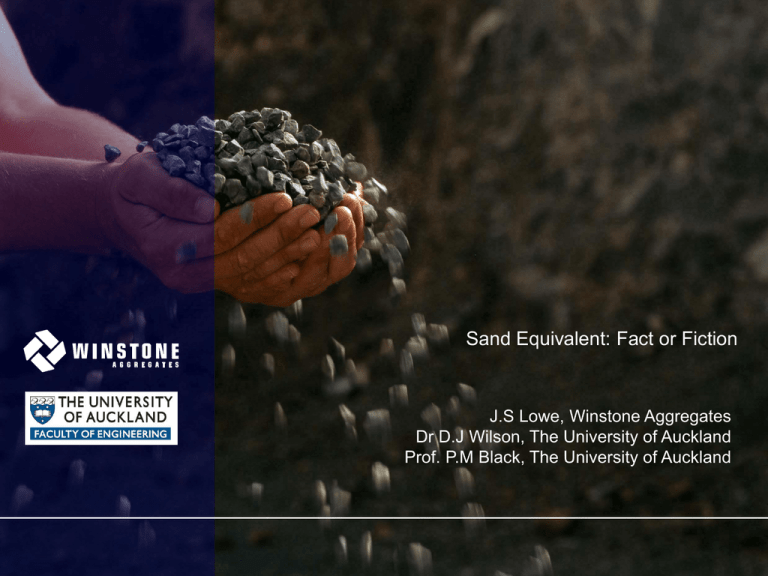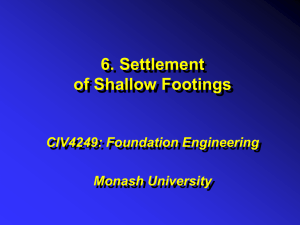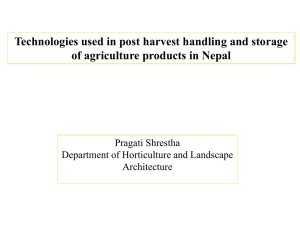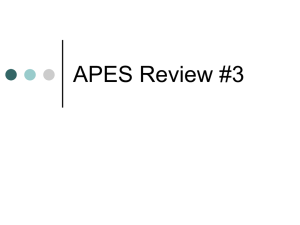Clay Index - Aggregate and Quarry Association
advertisement

Sand Equivalent: Fact or Fiction J.S Lowe, Winstone Aggregates Dr D.J Wilson, The University of Auckland Prof. P.M Black, The University of Auckland Contents Overview of common NZ cleanliness tests Sand Equivalent Initial Findings from Experimental Programme Conclusions Recommendations for further work Current New Zealand tests to classify the cleanliness of fine aggregates and sand Limit the amount of -75um material Sand Equivalent Developed 1954 by Hveem Methylene Blue or Clay Index Developed 1967 by Jones Plasticity Index Developed 1911 by Atterberg When are the tests applied to classify the cleanliness of fine aggregates and sand Typically: • All NZ Specifications limit the 75um Material • All commonly adopt Sand Equivalent • Clay Index less popular not used in concrete industry • Plasticity Index mainly used in roading applications No tests adapted specifically for uniqueness of NZ Rock sources SE testing to establish the cleanliness >$2m/annum Local aggregates are often dismissed due to non compliance with National NZ Specifications Sand Equivalent (SE) • Quickest of current tests taking approx 30 mins • Settling Test • Not directly measuring clay content, gives a potential • Simple and relatively cheap • Accuracy and repeatability concerns Initial Findings : Sand Equivalent Versus Clay Index Clay Index NZS 4407 6 5 4 3 2 1 0 20 25 30 35 40 45 50 55 Sand Equivalent NZS 4407 • Single quarry source & multiple products • Sample size = 90 • Lower CI with increasing SE • 37% of samples ≥40 (Sand Equivalent) • 87% of samples ≤3 (Clay Index) 60 65 70 Initial Findings: Sand Equivalent versus Clay Index 6 • Sample size = 197 • 24% of samples ≥40 (Sand Equivalent) • 74% of samples ≤3 (Clay Index) Clay Index NZS 4407 • Multiple Quarries and Products 5 4 3 2 1 0 Clay Index NZS4407 20 25 30 35 40 45 50 55 Sand Equivalent NZS 4407 10 8 6 4 2 0 20 30 40 50 Sand Equivalent NZS4407 60 70 60 65 70 Comparison with % passing 75um • Single quarry source & multiple products Clay Index NZS 4407 6 • Sample size = 90 • 37% of samples ≥40 (Sand Equivalent) • 87% of samples ≤3 (Clay Index) 5 4 3 2 1 0 • 63% of samples ≤7 (% Passing 75um) 20 25 30 35 40 45 50 55 Sand Equivalent NZS 4407 Sand Equivalent 70 60 50 40 30 20 0 5 10 % Passing 75um 15 20 60 65 70 Sand Equivalent v Clay Index 80 Number of Tests 400 Number of Companies 3 70 Number of Rock Types 2 Number of Quarries 8 Sand Equivalent 60 50 40 30 20 10 0 1 2 3 4 5 Clay Index • Multiple Quarries and Products • Sample size = 400 • 24% of samples ≥40 (Sand Equivalent) • 74% of samples ≤3 (Clay Index) 6 7 8 9 10 60 50 40 Sand Equivalent Greywacke Pap7 (Dry & Washed) Sand Equivalent 100 Number of tests = 61 90 80 70 30 20 10 0 16 0 /2 01 /2 3 /0 03 9/ 01 /2 0 /2 0 /2 01 /2 2 /0 2 /0 03 2/ 23 16 02 9/ 0 /2 0 /2 0 /2 01 /2 1 /0 1 /0 1 /0 02 2/ 26 19 12 01 /2 0 /2 0 /2 0 /2 00 /2 2 /1 2 /1 2 /1 01 5/ 29 22 15 12 8/ 0 /2 0 /2 0 /2 00 /2 1 /1 1 /1 1 /1 12 1/ 24 17 10 0 /2 0 /2 00 /2 0 /1 0 /1 11 3/ 27 20 10 0 0 10 10 0 0 10 10 10 0 09 09 09 9 9 09 09 09 9 09 09 Date 10 100 16 0 /2 01 /2 3 /0 03 9/ 01 /2 0 /2 0 /2 01 /2 2 /0 2 /0 03 2/ 23 16 02 9/ 0 /2 0 /2 0 /2 01 /2 1 /0 1 /0 1 /0 02 2/ 26 19 12 01 /2 0 /2 0 /2 0 /2 00 /2 2 /1 2 /1 2 /1 01 5/ 29 22 15 12 8/ 0 /2 0 /2 0 /2 00 /2 1 /1 1 /1 1 /1 12 1/ 24 17 10 0 /2 0 /2 00 /2 0 /1 0 /1 11 3/ 27 20 10 0 0 10 10 0 0 10 10 10 0 09 09 09 9 9 09 09 09 9 09 09 Date 9 Number of tests = 61 90 8 70 7 60 6 50 5 40 4 30 3 20 2 10 1 0 0 Clay Index 80 Sand Equivalent Greywacke Pap7 (Dry & Washed) Sand Equivalent Clay Index •AQA Technical Committee 1980 •Don Ferguson Greywacke Pap7 - SE Settlement Curves Pukekawa Settlement Curve Pap5 400 450 400 350 350 300 Settlement (mm) 250 200 250 150 100 200 50 0 1 150 1 2 3 4 5 6 7 8 9 10 11 12 13 14 15 16 17 18 19 20 2 3 4 5 6 7 8 9 10 11 12 13 14 15 16 17 18 19 20 21 Time (mins) 21 Time (mins) Otaika Settlement Curve (Pap 5) Flat Top Settlement Curve (Gap25) 450 450 400 400 350 350 300 Height of Column (mm) 300 250 200 250 200 150 150 100 100 50 50 0 1 0 1 2 3 4 5 6 7 8 9 10 11 12 13 14 15 16 17 18 19 20 2 3 4 5 6 7 8 9 10 11 12 13 14 15 16 17 15 16 17 18 19 20 21 Time (mins) 21 Time (mins) Greywacke TNZ40 - SE Settlement Curves Greywacke Gap65 - SE Settlement Curves 400 400 350 350 Settlement (mm) 300 300 Settlement (mm) Height of Column (mm) Settlement (mm) 300 250 250 200 200 150 1 150 2 3 4 5 6 7 8 9 10 11 12 13 Settlement Time (mins) 1 2 3 4 5 6 7 8 9 10 11 12 13 Settlement Time (mins) 14 15 16 17 18 19 20 21 14 18 19 20 21 Pap7 Settlement Curve 450 400 350 Settlement (mm) 300 250 200 150 100 50 0 1 6 11 16 21 26 31 36 41 Time (mins) 46 51 56 61 66 71 76 81 Greywacke Settlement Curves (washed pap 7) 450 400 350 Height of Column (mm) 300 250 200 150 100 50 0 1 2 3 4 5 6 7 8 9 10 11 12 Time (mins) 13 14 15 16 17 18 19 20 21 A suggested approach? • Steady State Sand Equivalent Allow full settlement to occur •Normalised Clay Index CIn = CI ( P x Wp ) Wci Where: CIn = normalised clay index CI = clay index (NZS 4407:1991) P = Percentage passing 75um (from particle size distribution) Wp = Weight of sample (from particle size distribution) Wci = Weight of sample (clay index) Conclusions Percentage of fines in NZ aggregate products does not appear excessive Evidence to suggest that using Sand Equivalent as primary test method is not maximising the use of NZ aggregates Clay Index and Sand Equivalent give differing levels of conformance for same sample Specifications can create testing and consistency issues for aggregate industry Specifications are reliant on adopted test methods for aggregates Further work •Relate results to specific swelling clays using XRD data. •Analysis of the ultrafines. •Comparison of SEss to CIn. • Develop SE and CI Prediction Models.









